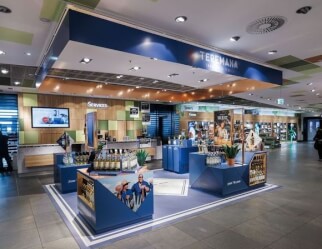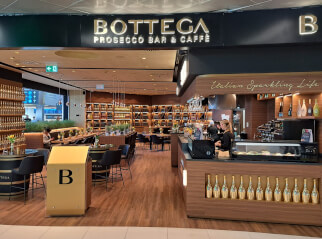Mapping the route to recovery
Tax Free World Association hosted its first webinar in early May to provide a platform for industry expert speakers to help paint a picture of what the future of the industry might look like.At the time, travel analytics company ForwardKeys shared some grim information on the situation. Americas Duty Free touched base with Olivier Ponti, Vice President Insights at ForwardKeys, to see if this was still the case four months later.
Olivier Ponti, Vice President Insights at ForwardKeys, explains that the situation the travel retail industry is in can still be described as "nightmarish"
In May, ForwardKeys predicted it would take the travel industry approximately three years to return to 2019 levels as a result of the blows it has sustained by the pandemic. However, Ponti now indicates that recovery will not be a homogenous process. Some regions will experience rapid recovery, while others a slower one. “Some segments will recover faster than others and it is possible that some parts of the business will never recover from the current crisis. So when we said two to three years, I think for some regions, yes that will be true. For some regions and sub-segments it may take much longer than that. I think that domestic travel is going to recover first,” explains Ponti.
Most recently, ForwardKeys has predicted that one of the largest tourism sectors to fully recover as early as September will be domestic travel in China. Domestic travel hit rock bottom in February, and it is slowly returning to its 2019 levels. Chinese airlines have become very aggressive with pricing and will likely continue to get people back in the air.
“The Chinese domestic market will be back on track. That is a good example of domestic travel being back on track. We have also seen some parts of the world like Europe being reactivated,” explains Ponti.
The beginning of June was ushered in with the reopening of many of these destinations and a willingness to travel from the moment many Southern European countries eased restrictions. He continues: “People started searching for flights to places like Greece, Portugal or Spain and started booking as well. So what travelers needed was clarity regarding a reopening date. It’s a rebound and it’s a reactivation. It’s not a recovery because we still are far away from 2019 levels.”
Cementing consumer confidence
Consumer confidence is a crucial piece of the travel journey that needs to be restored to ensure recovery. Ponti reveals that consumer confidence has been shattered during the last few months with people not feeling safe about getting on a plane, being in an airport, and not being properly informed about the situation regarding the pandemic in a given destination.
This, combined with airline behavior, has shaken the foundation of trust for travelers. When the pandemic initially unfolded, airlines displayed unconventional behavior when it came to a laundry list of items including: canceling flights at the very last minute; providing refunds; and announcing the reopening of routes when they were not reopened. Ponti explains that this resulted in lead times for bookings becoming incredibly short, showing that there is no planning ahead at this time and there is no confidence in the future.
Ponti describes future travel as being very fluid as the world adapts to the new reality
Ponti says that when it comes to the US, there have been signs of reactivations for domestic travel. “June was a month where we could see an increasing number of bookings. Unfortunately, by the end of June, with the number of cases being on the rise again, we could first see a plateau and then a decrease in the number of bookings being made. Since then it has progressively recovered, but we are still far away from last year’s levels. If we look at the week commencing August 10 for the US, we are at 36% of 2019 levels when it comes to domestic travel.” Once again, underscoring that this is a reactivation of the US market and not a recovery.
Riding the second wave
As countries start to show signs of stabilization, experts warn of the inevitable return of the second wave. Ponti reveals there has been a slowing number of bookings being made.
“That is something that is quite worrying. We can see a slowing of bookings as we are showing quite a similar pattern prior to the first wave, so it looks like we are clearly going towards a second wave and the situation will be tough for the entire industry. That said, I think the industry has learned from the first wave. New protocols have been put in place, the communication is better regarding what an airport experience looks like in terms of COVID-19, how to protect yourself as a traveler and how to protect others,” says Ponti.
Airlines are also scheduling flights based on pandemic scheduling and have adjusted their operations and communication with clients to run more efficiently. The key takeaway is now that airlines are prepared for the second wave.
Ponti also highlights that countries will not need to use blanket measures such as massive confinements or closing country borders, and will instead implement a more targeted approach. This may include closing specific neighborhoods within certain countries or destinations instead of closing the entire country. “I don’t expect the industry to go back to a complete standstill,” he says. “We will see people flying but there will be a constant readjustment of who is allowed to fly, willing to fly, and to which destination.”
Monitoring the future
ForwardKeys recently introduced the PowerBI Global Recovery Dashboard, a travel analytics tool that monitors data as travel restrictions change or develop.
The Global Recovery Dashboard can be used by analysts, marketers and hoteliers to explore the recovery of the travel and tourism market
Heading into the fall of 2020, travelers are searching for destinations such as the US, Spain and Thailand. However, there is a difference between searches and actual bookings. Traditionally at this time of year, people are searching for their Christmas holidays. Visits to friends and relatives (VFR) is a segment that continues to be more resilient than others. VFR is still fueling bookings during the 2020 Christmas period, but Ponti underscores that the situation can quickly change and those bookings may convert to cancelations.
Ponti reveals that reassurance for travelers in the future will strengthen consumer confidence and work as a great strategy to move forward. “The best thing is probably to have the pandemic under control, and to be efficient in the approach to preventing the virus spreading and negatively impacting the image of the destination and turning it into a destination perceived as unsafe for travelers.”









.jpg?&resize.width=322&resize.height=483)
